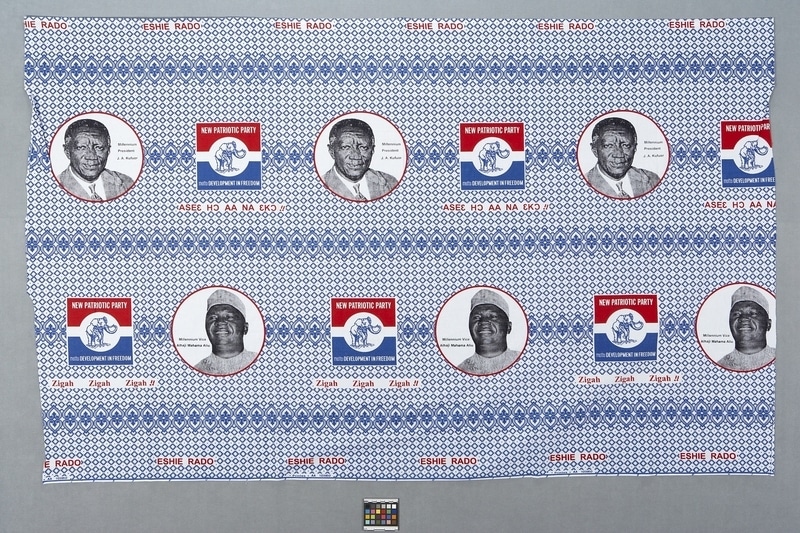Victory Textile Item Number: 2590/3 from the MOA: University of British Columbia

Description
Large contemporary, commemorative textile with a repeating pattern of blue geometrical shapes, dots, and horizontal bands of heart-shapes. Along the bottom and top there is red text. Two horizontal rows predominate in the middle. Each alternates an image of a man contained within a red circle with a square red, blue, and white emblem with an elephant with a blue outline in it. Text appears in the circles with the images in black; within the squares in white; in the background in red (not in English). Cloth is thin with a slight stiffness.
History Of Use
Cloth made to celebrate an electoral victory. Kufuor’s supporters wore clothing made from this cloth as a public statement of their allegiance.
Factory-printed cloths like this one commemorate or publicize special events. Consumers purchase the cloths and have them tailored into fashionable attire. Cloths are printed to commemorate a variety of events such as visits of dignitaries, funerals, university and church openings, the formation of women’s groups, beauty pageants, or New Year’s parties. Cloths may also be printed during and after elections to advertise political candidates. Some commemorative cloths are worn only for the special occasion for which the cloth was printed. The cloth is carefully stored away afterwards as a keepsake.
Factory-printed cloth is a product of both African design and European technology. African people have worn this type of cloth for over 150 years. It was originally printed in factories in Europe and then marketed in Africa, but today most of the cloth is designed and printed in Africa.
Iconographic Meaning
Males depicted are Ghanaian President John Kufuor and Vice President Alhaji Mahama Aliu. John Kufuor, leader of the New Patriotic Party, was officially inaugurated in January 2001. Throughout his political campaign he was known for his slogan, “asee ho”, and his downward pointing thumb. Asee ho, which means “bottom line” in the twi language, was used by Kufuor to instruct voters to place an ‘X’ on the bottom line, as that was his place on the electoral ballot.
Item History
- Made by Printex (Manufacturer) in Ghana ?
- Collected by Michelle Willard in Kumasi, Ghana during May 2001
- Owned by Michelle Willard before May 16, 2002
- Received from Michelle Willard (Seller) and Museum of Anthropology Acquisitions Budget (Funding source) on May 16, 2002
What
- Name
- Victory Textile
- Identification Number
- 2590/3
- Type of Item
- textile
- Material
- polyester fibre, dye, ink ? and cotton fibre
- Overall
- height 113.2 cm, width 178.3 cm
Who
- Culture
- Ghanaian
- Creator
- Printex (Manufacturer)
- Field Collector
- Michelle Willard
- Previous Owner
- Michelle Willard
- Received from
- Michelle Willard (Seller) and Museum of Anthropology Acquisitions Budget (Funding source)
Where
- Holding Institution
- MOA: University of British Columbia
- Made in
- Ghana ?
- Collected in
- Kumasi, Ghana
When
- Creation Date
- “/5 to 2001/5” ?
- Collection Date
- during May 2001
- Ownership Date
- before May 16, 2002
- Acquisition Date
- on May 16, 2002
Other
- Item Classes
- textiles
- Condition
- good
- Accession Number
- 2590/0003